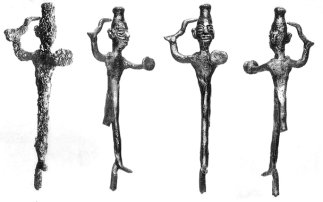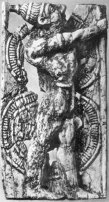Text
Certain magic and religious rituals in Greece probably derive from Mesopotamian ones. Among them is the practice of burying foundation deposits beneath a building. In the Near East various forms of foundation deposits emerge according to place and period. There are guardian figures and stone tablets with inscriptions buried under the buildings. Particularly widespread among the Assyrians was the practice of interring the valuable objects, different kinds of precious metal and precious stones, under temples and palaces. There are also less specific sacrificial rituals involving animal sacrifice and libations.
There are comparable, but not identical foundation offerings in the Minoan world: coloured pebbles from the sea, small vessels, seals, in one case even animal bones buried under the floor or the treshold of a sacred room. A deposit of eastern style, consisting of bronze objects deliberately deterred, has come to light under the Late Bronze Age Temple IV in Kition on Cyprus. The next find dates from around 800 BCE on Crete, where a family of goldsmiths of Syrian origin buried a deposit of gold artifacts and jewelry in a re-used tholos thomb at Knossos, rededicating it for their own use. One of two rich deposits excavated from the subsequent period was found at the wall of the earliest temple of Artemis on Delos, dated around 700 BCE. The other deposit belongs to the temple of Artemis at Ephesos, and is particularly rich, consisting of about 1000 objects. Among them are the oldest electron coins and it can be dated to sixth century BCE. Similar deposits of valuables are known from one of the temples at Perachora, from the temple of Poseidon at Isthmia, and from the temple of Athena in Priene. The foundation offering from Gortyn are simpler: two pits had been dug next to the temple wall in which there were the remains of the animal bones, of some kind of libations in the form of a vegetable paste and various small vessels. The whole was carefully covered with stone slabs on which a fire had been lit.
The interment of small valuables, in particular pieces of metal provides more specific evidence of the spread of a Mesopotamian practice, with the decisive leap across the Aegean linked to the emigration of craftsmen to Crete around 800. In the act of burying foundation deposits there is an inherent conviction that valuable offerings will ensure the permanent and undisturbed possession and safety of the building. In the Eastern texts, however much the builder may wish to come to the fore, the foundation succeeds “according to the message of the art of the conjurer”. It is probable, that the charismatic specialist, a migrant seer was also in attendance in the foundation rituals in Greece.
Bibliography
| Burkert 1992, 53-55 | Burkert, Walter. The Orientalizing Revolution. Near Eastern Influence on Greek Culture in the Early Archaic Period. Cambridge MA: Harvard University Press 1992. |
| de Santerre and Tréheux 1947/1948 | de Santerre, Hubert Gallet and Jacques Tréheux. “Rapport sur le depot égéen et géométrique de l'Artémision à Délos.” Bulletin de Correspondance Hellénique 71/72 (1947/1948) 148-254. |
Amar Annus
URL for this entry: http://www.aakkl.helsinki.fi/melammu/database/gen_html/a0001101.php
|


